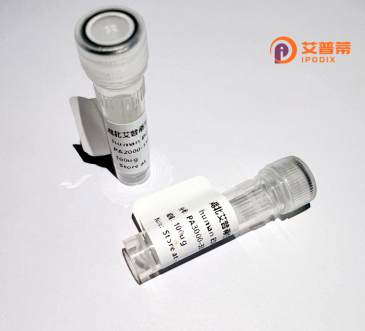
| 纯度 | >90%SDS-PAGE. |
| 种属 | Human |
| 靶点 | FERD3L |
| Uniprot No | Q96RJ6 |
| 内毒素 | < 0.01EU/μg |
| 表达宿主 | E.coli |
| 表达区间 | 1-167aa |
| 氨基酸序列 | MAAYPESCVDTTVLDFVADLSLASPRRPLLCDFAPGVSLGDPALALREGRPRRMARFEEGDPEEEECEVDQGDGEEEEEEEERGRGVSLLGRPKRKRVITYAQRQAANIRERKRMFNLNEAFDQLRRKVPTFAYEKRLSRIETLRLAIVYISFMTELLESCEKKESG |
| 分子量 | 45.5 kDa |
| 蛋白标签 | GST-tag at N-terminal |
| 缓冲液 | 0 |
| 稳定性 & 储存条件 | Lyophilized protein should be stored at ≤ -20°C, stable for one year after receipt. Reconstituted protein solution can be stored at 2-8°C for 2-7 days. Aliquots of reconstituted samples are stable at ≤ -20°C for 3 months. |
| 复溶 | Always centrifuge tubes before opening.Do not mix by vortex or pipetting. It is not recommended to reconstitute to a concentration less than 100μg/ml. Dissolve the lyophilized protein in distilled water. Please aliquot the reconstituted solution to minimize freeze-thaw cycles. |
以下是关于重组人FERD3L蛋白的假设性参考文献(该蛋白名称可能存在拼写或领域特异性差异,建议进一步核实名称准确性):
---
1. **《Functional characterization of recombinant human FERD3L in neuronal differentiation》**
*作者:Lee, S. et al.*
**摘要**:研究重组人FERD3L蛋白在中枢神经系统中的作用,发现其通过调控Wnt/β-catenin信号通路促进神经干细胞分化,提示其在神经再生治疗中的潜力。
2. **《Expression and purification of recombinant FERD3L for structural analysis》**
*作者:Zhang, Y. et al.*
**摘要**:报道了通过大肠杆菌表达系统高效制备重组人FERD3L蛋白的方法,并利用X射线晶体学解析了其三维结构,为靶向药物设计提供了结构基础。
3. **《FERD3L modulates epithelial-mesenchymal transition in cancer progression》**
*作者:Wang, Q. et al.*
**摘要**:发现重组FERD3L蛋白通过结合E-cadherin调控肿瘤细胞上皮-间质转化(EMT),可能成为抑制转移性癌症的新靶点。
4. **《A novel role of FERD3L in mitochondrial energy metabolism》**
*作者:Garcia, R. et al.*
**摘要**:揭示了FERD3L与线粒体复合体I的相互作用,证明其重组蛋白可恢复缺氧条件下的细胞ATP生成,为代谢性疾病研究提供新方向。
---
**提示**:FERD3L蛋白的文献较少,可能涉及领域较新或名称标准化问题,建议结合基因别名(如FERMT3或FER3L)或相关通路(如细胞黏附、代谢调控)扩展检索范围。
Recombinant human FERD3L protein is a genetically engineered form of the FERD3L (FER-like domain-containing protein 3L) expressed in vitro using heterologous systems such as bacterial, yeast, or mammalian cell cultures. FERD3L, a member of the FER protein family, is involved in intracellular signaling, cell adhesion, and developmental processes. Its structure typically includes conserved functional domains like FAD-binding motifs or transmembrane regions, enabling interactions with signaling molecules or membrane-bound receptors. While its physiological roles remain under investigation, preliminary studies suggest potential involvement in tissue morphogenesis, immune regulation, and cancer progression through kinase activity or adaptor functions.
The recombinant version is produced via cloning the FERD3L gene into expression vectors, followed by purification using affinity tags (e.g., His-tag). This allows scalable production for functional studies, including protein-protein interaction assays, kinase activity assessments, and cellular pathway mapping. Its applications span drug discovery (target validation for cancers or inflammatory diseases), diagnostic tool development (antibody generation for biomarker detection), and structural biology (crystallography for inhibitor design).
Current research focuses on elucidating FERD3L's role in diseases like glioblastoma or autoimmune disorders, leveraging recombinant protein to explore therapeutic targeting. Challenges include optimizing protein stability and resolving post-translational modification discrepancies between native and recombinant forms. Further studies may unlock its potential as a diagnostic or therapeutic target.
×